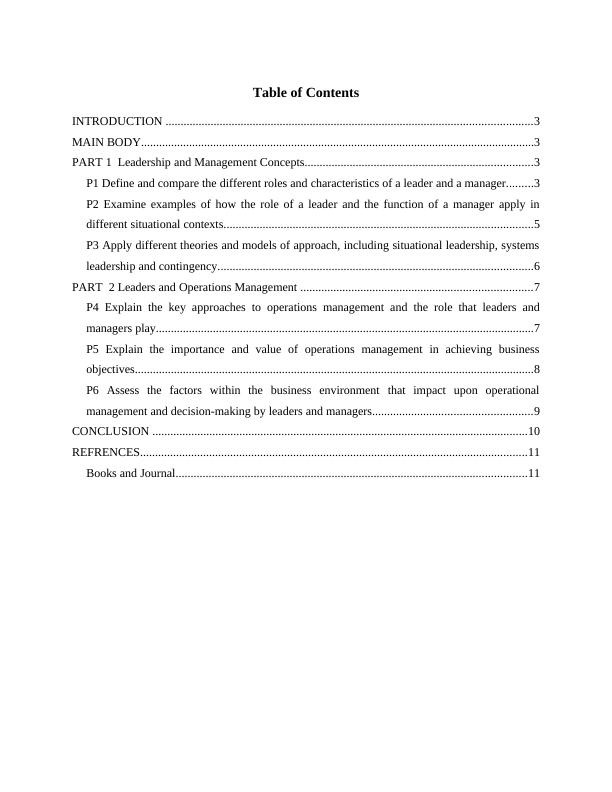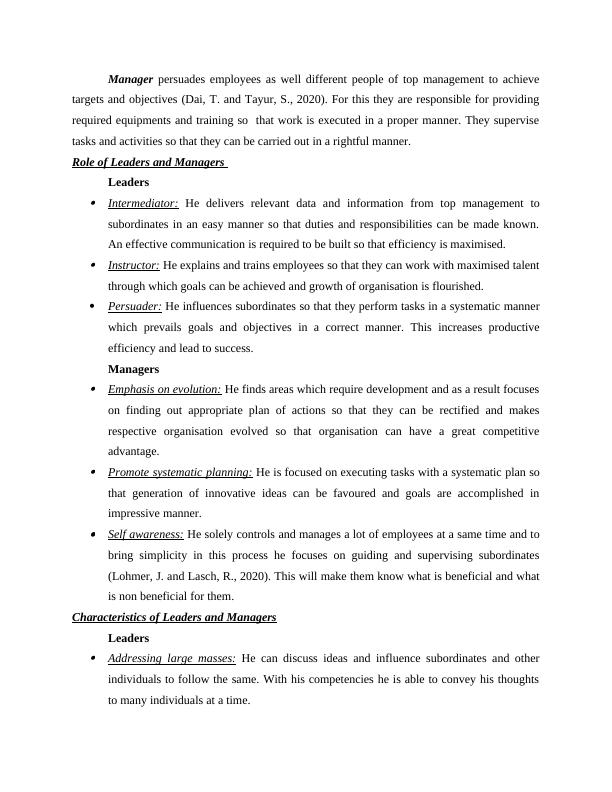Management and Operations: Roles, Characteristics, and Approaches
Added on 2022-12-28
11 Pages3705 Words66 Views
Management and
Operations
Operations

Table of Contents
INTRODUCTION ..........................................................................................................................3
MAIN BODY...................................................................................................................................3
PART 1 Leadership and Management Concepts............................................................................3
P1 Define and compare the different roles and characteristics of a leader and a manager.........3
P2 Examine examples of how the role of a leader and the function of a manager apply in
different situational contexts.......................................................................................................5
P3 Apply different theories and models of approach, including situational leadership, systems
leadership and contingency.........................................................................................................6
PART 2 Leaders and Operations Management .............................................................................7
P4 Explain the key approaches to operations management and the role that leaders and
managers play..............................................................................................................................7
P5 Explain the importance and value of operations management in achieving business
objectives.....................................................................................................................................8
P6 Assess the factors within the business environment that impact upon operational
management and decision-making by leaders and managers.....................................................9
CONCLUSION .............................................................................................................................10
REFRENCES.................................................................................................................................11
Books and Journal.....................................................................................................................11
INTRODUCTION ..........................................................................................................................3
MAIN BODY...................................................................................................................................3
PART 1 Leadership and Management Concepts............................................................................3
P1 Define and compare the different roles and characteristics of a leader and a manager.........3
P2 Examine examples of how the role of a leader and the function of a manager apply in
different situational contexts.......................................................................................................5
P3 Apply different theories and models of approach, including situational leadership, systems
leadership and contingency.........................................................................................................6
PART 2 Leaders and Operations Management .............................................................................7
P4 Explain the key approaches to operations management and the role that leaders and
managers play..............................................................................................................................7
P5 Explain the importance and value of operations management in achieving business
objectives.....................................................................................................................................8
P6 Assess the factors within the business environment that impact upon operational
management and decision-making by leaders and managers.....................................................9
CONCLUSION .............................................................................................................................10
REFRENCES.................................................................................................................................11
Books and Journal.....................................................................................................................11

INTRODUCTION
An organisation to complete its production in a proper manner is requires to have an
efficient management and operational team that supports and brings out hurdles in a sheer way.
Management is a term which defines follow up of management functions. The scope of
management is very wide and involves functions namely, planning, controlling, coordinating,
directing, supervising, organising, leading and much more. This makes operations of enterprise
executed in a smooth manner. Whereas, operations can be termed as day to day activities which
is performed by respective individuals of organisations and result in meeting the targeted goals
and objectives of organisation. Both the terms are interconnected and cannot do without each
other. Management comprises of personnels who are the major stakeholders and take relevant
decisions which decide upcoming process. They are further categorised as per the tasks they
perform and their work quality (Bhaumik, P.K., 2018). They can be categorised as leaders and
managers which perform their own tasks and execute accordingly. The report is a study on
management and operations of TESCO Plc. It is a multinational British groceries and
merchandise retail chain market. It has a diversified market reach and is dealing in wide variety
of goods and services, catering needs of all range of individuals. It generates an appreciable
amount of revenues in mainly seven countries around Asian and European continents. The report
studies organisational structure of TESCO defining roles and characteristics of managers and
leaders. The first part explains related leadership styles, theories and approaches, on the other
hand second part explains role of leaders and managers in operations and their relationship in
business environment.
MAIN BODY
PART 1 Leadership and Management Concepts
P1 Define and compare the different roles and characteristics of a leader and a manager.
Defining Leaders and Managers
Leader supervises and guides their subordinates in a particular direction through which
they can work for achievement of a pre determined common goal. He works towards attainment
of mission and vision statements of a company by taking into consideration the organisational
achievements. He follows relevant leadership styles, theories and approaches to control a
problem in a correct manner.
An organisation to complete its production in a proper manner is requires to have an
efficient management and operational team that supports and brings out hurdles in a sheer way.
Management is a term which defines follow up of management functions. The scope of
management is very wide and involves functions namely, planning, controlling, coordinating,
directing, supervising, organising, leading and much more. This makes operations of enterprise
executed in a smooth manner. Whereas, operations can be termed as day to day activities which
is performed by respective individuals of organisations and result in meeting the targeted goals
and objectives of organisation. Both the terms are interconnected and cannot do without each
other. Management comprises of personnels who are the major stakeholders and take relevant
decisions which decide upcoming process. They are further categorised as per the tasks they
perform and their work quality (Bhaumik, P.K., 2018). They can be categorised as leaders and
managers which perform their own tasks and execute accordingly. The report is a study on
management and operations of TESCO Plc. It is a multinational British groceries and
merchandise retail chain market. It has a diversified market reach and is dealing in wide variety
of goods and services, catering needs of all range of individuals. It generates an appreciable
amount of revenues in mainly seven countries around Asian and European continents. The report
studies organisational structure of TESCO defining roles and characteristics of managers and
leaders. The first part explains related leadership styles, theories and approaches, on the other
hand second part explains role of leaders and managers in operations and their relationship in
business environment.
MAIN BODY
PART 1 Leadership and Management Concepts
P1 Define and compare the different roles and characteristics of a leader and a manager.
Defining Leaders and Managers
Leader supervises and guides their subordinates in a particular direction through which
they can work for achievement of a pre determined common goal. He works towards attainment
of mission and vision statements of a company by taking into consideration the organisational
achievements. He follows relevant leadership styles, theories and approaches to control a
problem in a correct manner.

Manager persuades employees as well different people of top management to achieve
targets and objectives (Dai, T. and Tayur, S., 2020). For this they are responsible for providing
required equipments and training so that work is executed in a proper manner. They supervise
tasks and activities so that they can be carried out in a rightful manner.
Role of Leaders and Managers
Leaders Intermediator: He delivers relevant data and information from top management to
subordinates in an easy manner so that duties and responsibilities can be made known.
An effective communication is required to be built so that efficiency is maximised. Instructor: He explains and trains employees so that they can work with maximised talent
through which goals can be achieved and growth of organisation is flourished.
Persuader: He influences subordinates so that they perform tasks in a systematic manner
which prevails goals and objectives in a correct manner. This increases productive
efficiency and lead to success.
Managers Emphasis on evolution: He finds areas which require development and as a result focuses
on finding out appropriate plan of actions so that they can be rectified and makes
respective organisation evolved so that organisation can have a great competitive
advantage. Promote systematic planning: He is focused on executing tasks with a systematic plan so
that generation of innovative ideas can be favoured and goals are accomplished in
impressive manner. Self awareness: He solely controls and manages a lot of employees at a same time and to
bring simplicity in this process he focuses on guiding and supervising subordinates
(Lohmer, J. and Lasch, R., 2020). This will make them know what is beneficial and what
is non beneficial for them.
Characteristics of Leaders and Managers
Leaders Addressing large masses: He can discuss ideas and influence subordinates and other
individuals to follow the same. With his competencies he is able to convey his thoughts
to many individuals at a time.
targets and objectives (Dai, T. and Tayur, S., 2020). For this they are responsible for providing
required equipments and training so that work is executed in a proper manner. They supervise
tasks and activities so that they can be carried out in a rightful manner.
Role of Leaders and Managers
Leaders Intermediator: He delivers relevant data and information from top management to
subordinates in an easy manner so that duties and responsibilities can be made known.
An effective communication is required to be built so that efficiency is maximised. Instructor: He explains and trains employees so that they can work with maximised talent
through which goals can be achieved and growth of organisation is flourished.
Persuader: He influences subordinates so that they perform tasks in a systematic manner
which prevails goals and objectives in a correct manner. This increases productive
efficiency and lead to success.
Managers Emphasis on evolution: He finds areas which require development and as a result focuses
on finding out appropriate plan of actions so that they can be rectified and makes
respective organisation evolved so that organisation can have a great competitive
advantage. Promote systematic planning: He is focused on executing tasks with a systematic plan so
that generation of innovative ideas can be favoured and goals are accomplished in
impressive manner. Self awareness: He solely controls and manages a lot of employees at a same time and to
bring simplicity in this process he focuses on guiding and supervising subordinates
(Lohmer, J. and Lasch, R., 2020). This will make them know what is beneficial and what
is non beneficial for them.
Characteristics of Leaders and Managers
Leaders Addressing large masses: He can discuss ideas and influence subordinates and other
individuals to follow the same. With his competencies he is able to convey his thoughts
to many individuals at a time.

End of preview
Want to access all the pages? Upload your documents or become a member.
Related Documents
Management and Operations: Roles and Characteristics of Leaders and Managerslg...
|13
|4070
|91
Management and Operations: Roles and Characteristics of Manager and Leaderlg...
|14
|3823
|100
Management and Operationslg...
|15
|5272
|28
Management and Operations: Roles and Characteristics of Manager and Leaderlg...
|16
|4855
|29
Importance of Operations Management in Achieving Business Objectiveslg...
|12
|3681
|44
Leadership and Management Operations at Tescolg...
|16
|4500
|98